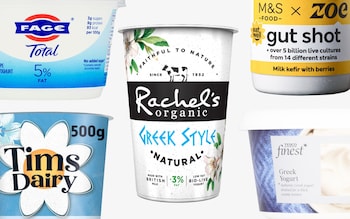Weight loss drugs: Oprah’s on them, Elon’s tried them and even Boris gave them a whirl (they didn’t agree with him). Ozempic, in case you haven’t heard, is a Type 2 diabetes treatment which is also prescribed for its weight loss effects. The medicines regulator has since approved a higher dose under the brand name Wegovy to treat obesity. The active ingredient in both drugs is semaglutide which works by mimicking the action of the GLP-1 hormone which is generally released by the gut after a meal. GLP-1 signals to the brain that we are full, preventing us from overeating.
Understandably, you may be hesitant to inject yourself with a drug and the side effects aren’t pleasant either, from nausea to constipation and heartburn. Thankfully, we can all regulate our appetite more naturally by increasing the foods that trigger the release of the same fullness hormone as Ozempic.
Oats and whole grains
Always first to jump on a trend, those zealous TikTokers have been all over this one with the recent ‘Oatzempic’ craze – an oat-rich smoothie touted as “Ozempic in a glass”. And they may be on to something. If you are partial to a morning bowl of porridge you’ll already know how filling it is, indeed a 2016 study found that the soluble fibre contained in oats and other whole grains is fermented by the gut producing short-chain fatty acids (SCFAs) which stimulate GLP-1 release.
If you’re not a fan of porridge’s gloopy texture, why not blend some oats into a smoothie along with other fibre-rich ingredients for a satiating start to the day? Place 2 tbsp oats in a blender, pulse a few times to grind before adding 100g frozen mixed berries, a small ripe banana, 1 tbsp peanut butter and 100ml milk. Blend until smooth and drink straight away.
Eggs
Not only are eggs rich in protein, which takes longer to digest than fat or carbohydrate and so keeps us feeling full for longer but recent research has found that egg whites contain peptides that stimulate GLP-1 production. But don’t worry, there’s no need to resort to tasteless egg-white omelettes. The yolks contain an abundance of essential nutrients including vitamins B2, B12 and D, choline, selenium and iodine, and research now shows that the cholesterol in eggs does not significantly raise the levels of “bad” cholesterol in our blood.
For extra protein, try these easy baked eggs with ham and seasonal asparagus spears. Preheat the oven to 180C fan and lightly grease as many holes of a muffin tin as you have eggs. Line each hole with a slice of ham, crack in an egg, season and bake for 10 minutes (or until cooked to your liking). Soften some asparagus spears in boiling water for a few minutes and serve alongside the baked eggs to dip into the yolks.
Nuts
Nuts are little nutritional powerhouses packed with protein and fibre, which we’ve already seen are both important for GLP-1 release. They also contain a good amount of healthy fat which attenuates the body’s insulin response, further supporting the production of GLP-1.
Having a small handful of nuts as a snack is easy enough, but including nuts in meals is an excellent way to prevent postprandial glucose spikes. Make a crunchy, spicy nut topper for sprinkling over soup instead of croutons and salads for extra flavour and texture. Preheat the oven to 180C fan. In a bowl, mix 2 tbsp extra virgin olive oil with 1 tsp cumin, 1 tsp turmeric, ½ tsp chilli powder and a little salt. Add 200g roughly chopped, mixed nuts and coat well. Roast in the hot oven for 15 minutes. It will keep in an airtight container for three weeks.
Avocado
Avocados are not just a great source of satiating monounsaturated healthy fats, a 2019 study by the Center for Nutrition Research at the Illinois Institute of Technology found that eating an avocado with a meal increased participant’s levels of GLP-1, as well as another appetite-regulating hormone called peptide YY, while also reducing insulin levels.
If you find the texture of avocados a bit off-putting, they work exceptionally well blended with banana into a creamy thick shake, perfect for breakfast or to stave off the mid-afternoon munchies. Place 1 ripe banana, ½ a ripe avocado, 100ml milk, 1 tsp honey (optional), ½ tsp cinnamon and a handful of ice cubes into a blender and blend on high for 30 seconds until smooth. Drink immediately.
Veggies before a meal
If you are a fan of Jessie Inchauspé, the self-titled ‘Glucose Goddess’, whose 2022 book The Glucose Revolution has sold more than a million copies, one of her key pieces of advice is to have a “green starter” before a meal. A 2022 study found that consuming vegetables before a meal regulated blood sugar levels and increased GLP-1 levels, especially 60 minutes after eating.
So it seems the side salad (or should we call it the starter salad?) is due a revival. Keeping it simple is key – use whatever you have to hand in your salad drawer and add a delicious dressing of olive oil, Dijon mustard, apple cider vinegar (which also helps moderate blood sugar levels), honey, dried mixed herbs and a little salt and pepper.
Disclaimer: The copyright of this article belongs to the original author. Reposting this article is solely for the purpose of information dissemination and does not constitute any investment advice. If there is any infringement, please contact us immediately. We will make corrections or deletions as necessary. Thank you.



